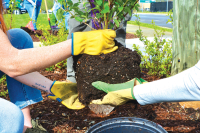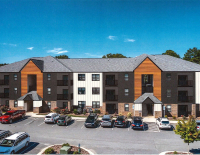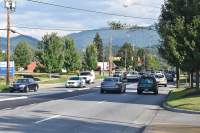New signs will bring greenways under one banner
 Finding the patchwork of greenway paths scattered across Haywood County is a bit like a scavenger hunt.
Finding the patchwork of greenway paths scattered across Haywood County is a bit like a scavenger hunt.
A loop along the Pigeon River in Clyde, a paved walking track in Maggie Valley, a creekside path in Waynesville — add them up, and there’s several miles of greenway trails hidden in plain sight.
An initiative to install universal signage at all the greenways in the county aims to demystify the whereabouts of the walking paths.
“The focus of our project is to build awareness of the greenways we already have here in Haywood County,” said Martha Bradley, a member of the Haywood County Chamber of Commerce Young Professionals group, which is spearheading the effort.
The greenway sign project is being funded with a $25,000 grant from the New Generations Leaders program through the N.C. Rural Center.
The grant has virtually no strings attached. The Young Professionals could put the money toward any sort of project or undertaking they could dream up. There were only two parameters: the project had to have economic impact and make rural communities more appealing to young people.
Related Items
So the brainstorming began. Greenways quickly rose to the top.
“A greenway is a destination. It makes the area more attractive for those of us who live here, but it is also bonus for people looking to move here,” said Melissa Tinsley, a member of the chamber’s young professionals group.
Economic benefit? Check.
Quality-of-life perk for the under-40 set? Also check.
“For younger people it is very attractive to have a greenway, whether you’re walking to the store or walking your dog or somewhere to ride bikes,” Tinsley said. “It is a great thing to add to the community portfolio.”
Aside from the obvious recreation virtues, greenways reduce congestion, provide wildlife habitat corridors, and encourage healthy lifestyles, Bradley said.
Bradley said the group briefly flirted with the idea of building interconnections between disparate greenway segments.
“But $25,000 starts to disappear really quickly when you start talking about building trails,” Bradley said.
The next best thing was to showcase the greenway segments already on the ground.
“We have noticed there has not been a cohesive strategy to promote a single brand to the public,” Bradley said.
Of course, they still dream of a day when a sprawling greenway system threads without gaps through the county. And they aren’t alone.
“The greenways in Haywood County have a long history. We don’t claim to be the first people to come up with this idea,” Bradley admitted. “Everyone gets really excited about building an expansive and unified greenway system.”
The signage initiative will hopefully be a catalyst for that long-range goal, Bradley said.
“We wanted to get something tangible and visible in the community,” Tinsley added.
The project had an important side-effect. It brought together future community leaders to create, coordinate and carry through a civic project.
In fact, that is one of the goals of the New Generations grant. It’s hard to say which will have the most lasting community impact — the tangible greenway signs or the cultivation of tomorrow’s leaders.
“This grant is really focusing on active engagement, learning about the civic and economic affairs of the community, and then as a group working with the community and economic development leaders to develop a community improvement project,” said Katy Gould, another member of the group and director of the HCC Small Business Center.
The Young Professionals hit a homerun with the greenway project. It allowed them to intersect with every town in the county.
“That was a target. We picked a project that would impact every municipality,” Gould said.
Since there were so many moving parts, everyone had a chance to run point on some aspect of the project. They had to elicit the support of all four towns — Waynesville, Maggie Valley, Canton and Clyde — as well as the county in order to gather their various greenway legs under collective signage.
Unified signs will make the different greenways instantly recognizable as part of a larger system, albeit a patchwork one.
That’s particularly helpful in Maggie Valley, where there’s a few creekside walking paths and pocket parks — think green space with picnic tables and fishing access — connected by sidewalk.
“Getting a contiguous greenway all along Jonathan Creek would be impossible. So we have these park nodes,” said Andrew Bowen, the town planner with Maggie Valley and a member of the Young Professional’s group.
Even though sidewalks connect them, people may not realize there’s another greenway section ahead if they just kept going. To that end, a series of smaller directional signs will be installed as part of the project.
“Almost as important are these little small wayfinding arrows,” Bowen said.
Each of the four towns have embraced the signage initiative, especially since signing on the dotted line didn’t cost the towns any money — they simply had to be willing to allow the signs to be put in along the paths of their respective greenway networks. The same was true for the county.
The groups had logistics to navigate as well as the civic arena. They had to choose sites for the signs, develop a logo and verbiage, get bids from sign companies — and now they have to get them in the ground.
“We had a lot of people step up to really make it happen,” Gould said.









